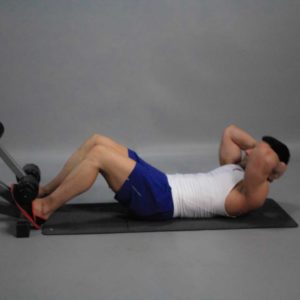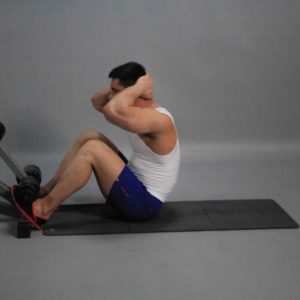

Preparation
Get professional advice to decide when and how this advanced exercise is right for you. You will need a low rail, leg pad or similar structure which allows you to push the back of your feet against it. Alternatively, a coach or training buddy can hold your feet with his hands. You might prefer to use a gymnastic mat or other soft support to lay down on it. Lay down on the back and stick the feet under the rail or pad. The legs are bent with an angle of ninety degrees in the knees. Relax your arms, touching the cheeks with your fists or rest the fingers on the back of your head. Exhale and activate the abdominals a few times. Feel how you control the neutral position of the lower back. Depending on how strongly curved it is and possibly past injuries you might decide to put a pillow under your lower back
Start Position
Strongly engage your abdominals to take the weight off your shoulder blades. Keep the arms and neck relaxed. If you struggle to keep this position for a while you should continue to build up abdominal strength with crunches or other exercises first
2��
Engage the abdominals to lift the shoulders from the floor and bring your rib cage closer to the pelvis. Don't allow the lower back to bend. Engage the front of the thighs and hip flexors to pull your upper body further up and forward toward a sitting position. Don't allow the pelvis to tilt forward. If needed, push the back of the feet against the leg pad. Keep the heels on the ground
End Position
Pull the upper towards the knees as far as you can maintain a proper neutral lower back. Going all the way up makes it a full sit-up
2��
Lower the upper body back to the ground. Keep the legs and abdominals engaged to make the movement slow and controlled. Maintain a neutral lower back
Repeat
Back to the start position. Repeat for the planned number of times
f'�
Kraft für das Beinheben oder Hüftbeugen. Beckenstabilität. Kräftigung der Bauch- und Lendenmuskeln, besonders des geraden Bauchmuskels und des Lenden-Darmbeinmuskels